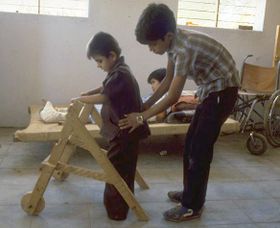Hesperian Health Guides
Activities for Standing, Walking, and Balance
HealthWiki > Disabled Village Children > Chapter 35: Early Stimulation and Development Activities > Activities for Standing, Walking, and Balance
Usually a child progresses through these stages:
| bears part of weight automatically when held like this (standing reflex) |
automatically steps if tilting forward (stepping reflex) |
sinks down when stood up, |
 |
 |
 |
| 0-3 months | 0-3 months | 3-6 months |
| stands holding on |
pulls up to standing | steps sideways holding on | steps between objects | walks with 2 hands, 1 hand, and finally, no support | |
 |
 | ||||
| 7-9 months | 9-12 months | 9-12 months | 1-3 years | ||
You can prepare a child for walking by encouraging each of the above stages as the child develops.
| Hold the baby so that she uses the early stepping reflex to strengthen her legs. You can even bounce the baby gently. | When the child begins to stand, support her hips with your hands. Spread her feet apart to form a wide base. First do this from in front, later from behind. | |
 |
 |
Move her gently from side to side, so that she learns to shift her weight from one leg to the other. |
|
CAUTION! In children with spasticity, this activity may increase muscle stiffness. DO NOT DO IT. |
||
| As she gains better balance, you can provide a light support at the shoulders. | Or have the child hold a hose or rope. Because it is flexible, he needs to balance more. |
 |
|

Later, he can hold onto the rope with one hand only. |
| To encourage a child to pull up to standing, put a toy he likes on the edge of a table. | When a child can almost walk alone but is afraid of falling, tie a cloth around his chest. | ||
 |
Hold the cloth, but let it hang completely loose. Be ready to catch him if he falls. |  | |
| To encourage him to take steps, put something he likes at the other end of the table. |
CAUTION! Do not let the child hang by the cloth. Have him bear his own weight. The cloth is only to catch him if he falls. | ||
Other activities for improving balance:
| Hold the child loosely under the arms and gently tip him from side to side and forward and backward. Allow him to return to a straight position. Turn it into a game. |  |
At first support the child while you do this. When his balance improves, do it without supporting him—but be ready to catch him if he falls. |
| Practice walking sideways and backward. | It is better to hold a child: | ||
 |
 LIKE THIS
NOT LIKE THIS
His balance is centered in his body.
His balance is off center. |
||
Support your child only as much as he needs, until he can walk by himself.

Draw a square on the ground and help him to take steps forward, sideways, and backward. Follow the 4 sides of the square, always facing the same direction. Make it fun by having him collect a different colored tag or piece of puzzle at each corner—or however you can. |
| For the older child with poor balance, a homemade balance board will turn developing better balance into a game. Move slowly at first—especially with a child with cerebral palsy. |
 |
A balance board with a wide rocker is better because it rocks more smoothly. |
 | |
| Blocks to prevent rolling sideways. | Some children will need a pole to hold onto. |
| Simple homemade parallel bars can help a child with weak legs or a difficulty with balance get started walking. | Homemade pushcarts or walkers can provide both support and independence for the child who is learning to walk or who has difficulty with balance. |
 |
 |
 |
A simple wooden walker with plywood wheels helps this developmentally delayed child begin to walk. |


